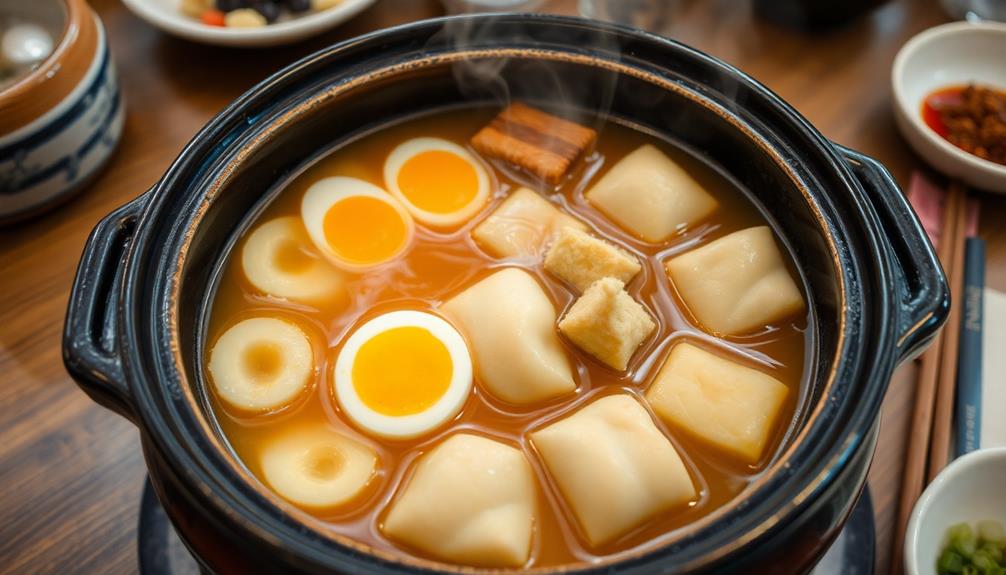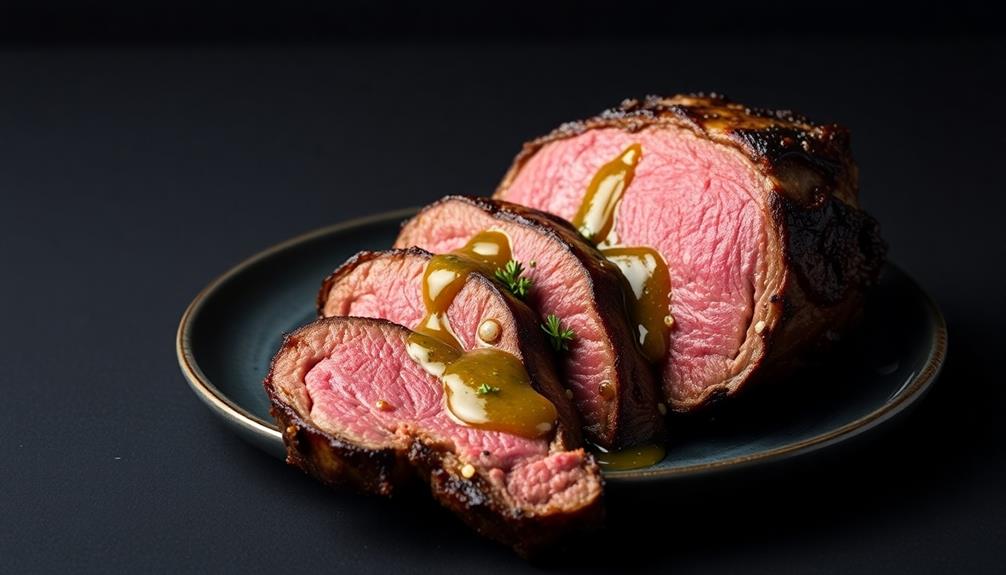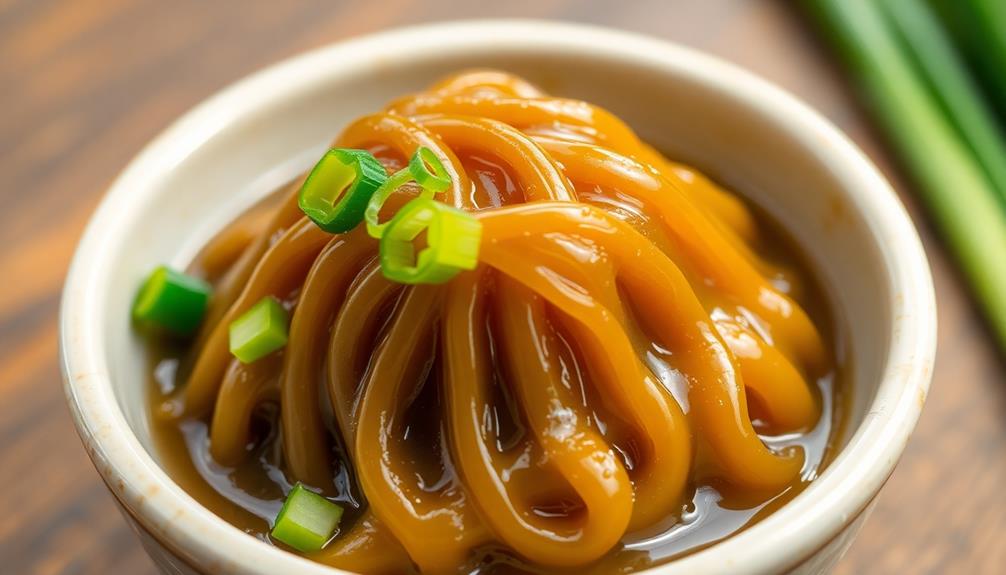Oden, the iconic Japanese winter hotpot, is more than just a simple dish – it's a cultural phenomenon that warms both the body and the soul. As you delve into its rich history and savory flavors, you'll uncover the deep-rooted traditions and communal spirit that make this simmering pot a beloved centerpiece of gatherings and celebrations. From the Edo-era origins to the modern-day adaptations, the story of oden is one that speaks to the heart of Japanese cuisine and the enduring power of shared experiences. Prepare to be captivated as you explore the depth and complexity of this winter wonder.
Key Takeaways
- Oden is a traditional Japanese winter dish, originating during the Edo period as a warming street food.
- Regional variations exist, with Kanto oden using soy sauce-based broth and Kansai oden using dashi-infused broth.
- Key oden ingredients include boiled eggs, daikon radish, and various fish cakes, which are simmered in the broth.
- Oden is considered a cultural staple, often enjoyed during festivals and special occasions, representing the importance of communal meals.
- The slow simmering of oden enhances the flavors and tenderness of the ingredients, creating a comforting and warming dish.
History
Oden, the beloved Japanese winter hotpot, has a rich history that can be traced back centuries. This savory dish originated in the Edo period, when it was first enjoyed by the common people as a warming street food. Vendors would push their oden carts through the chilly streets, offering a variety of ingredients simmered in a flavorful broth.
Over time, oden evolved, with each region developing its own unique style. In Kanto, the broth is often soy sauce-based, while Kansai oden features a more complex, dashi-infused liquid. Ingredients like boiled eggs, daikon radish, and various types of fish cakes became staples, each adding its own texture and taste.
Today, oden remains a beloved part of Japanese culture, particularly during the winter months. Families and friends gather to enjoy this comforting dish, savoring the warmth and rich flavors that have been passed down for generations.
Recipe
Oden, a beloved Japanese winter dish, is a comforting and satisfying hotpot that brings warmth and togetherness to the table. This traditional dish features a variety of ingredients simmered in a flavorful dashi broth, creating a harmonious blend of flavors and textures.
The beauty of oden lies in its simplicity and versatility. It can be customized to suit individual preferences, making it a dish that can be enjoyed by people of all ages and tastes. Whether you're looking for a cozy and comforting meal or a way to explore the rich culinary traditions of Japan, oden is sure to delight your senses.
- Dashi (Japanese stock)
- Daikon radish, cut into 1-inch pieces
- Boiled eggs
- Fried tofu pouches (aburaage)
- Konjac noodles (konnyaku)
- Fish cakes (kamaboko)
- Shirataki noodles
- Cabbage, cut into bite-sized pieces
- Green onions, sliced
To prepare the oden, start by bringing the dashi to a gentle simmer in a large pot. Gently add the prepared ingredients, ensuring they're fully submerged in the flavorful broth.
Allow the oden to simmer for 30-45 minutes, or until the ingredients are tender and have absorbed the rich, umami-packed flavors.
When serving, ladle the oden and its broth into individual bowls, allowing each person to customize their dish with their preferred toppings and condiments, such as Japanese karashi mustard or soy sauce.
The slow-simmered ingredients and the comforting warmth of the broth make oden a truly satisfying and nourishing meal, perfect for chilly winter days.
Cooking Steps
Bring the dashi broth to a gentle simmer in a large pot.
Next, add the various ingredients and let them cook for about 10 minutes, allowing the flavors to meld.
Step 1. Bring Dashi Broth to a Simmer
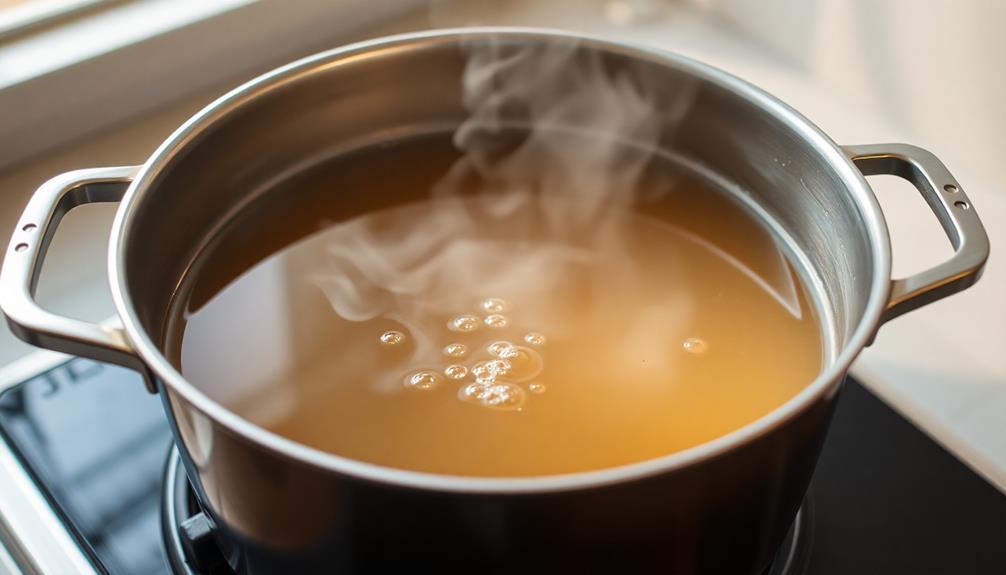
Once the dashi broth has been prepared, you'll want to bring it to a gentle simmer. In a large pot, pour in the flavorful dashi and set it over medium heat. As the liquid begins to heat up, you'll see small bubbles start to form on the surface. This is a sign that the broth is coming to a simmer.
Maintain the heat at a medium setting, stirring occasionally to ensure even heating. You don't want the broth to boil rapidly, as that can cause the flavors to become muted. Instead, you're aiming for a gentle, steady simmer. This allows the various ingredients in the oden dish to gently cook and infuse the broth with their unique tastes.
Once the broth is simmering, you can begin adding your chosen oden ingredients, such as daikon radish, boiled eggs, and fish cakes. Adjust the heat as needed to keep the broth at a consistent simmer throughout the cooking process.
Step 2. Add Ingredients

With the dashi broth simmering, you can now start adding your desired oden ingredients.
Begin by carefully dropping in the hard-boiled eggs, allowing them to gently poach in the rich, savory broth. Next, add the slices of daikon radish, which will absorb the flavors and become wonderfully tender.
Slip in the firm, chewy pieces of konnyaku, a jelly-like root vegetable that provides a unique textural contrast.
As the oden simmers, you can layer in the juicy pieces of pork belly, letting them slowly cook and infuse the broth with their succulent flavors.
Don't forget the delicate, pillowy tofu cubes, which will soak up the dashi's umami essence. Finally, drop in the firm, white fishcakes, allowing them to warm through and develop a delightful springy texture.
Once all the ingredients have been added, let the oden simmer for 10-15 minutes, allowing the flavors to meld together in perfect harmony.
The result is a warming, comforting dish that celebrates the season's finest ingredients.
Step 3. Simmer Ingredients for 10 Minutes

Now that you've added all the ingredients, let's simmer them for 10 minutes. Bring the pot to a gentle boil over medium heat. Once it's bubbling, reduce the heat to maintain a steady simmer. Set a timer for 10 minutes and let the flavors meld together.
During this time, the ingredients will slowly release their essence into the broth, creating a rich, aromatic base. Gently stir the pot occasionally to ensure even cooking. The daikon radish will become tender, the konnyaku (yam cake) will soften, and the boiled egg will fully cook through.
Keep a close eye on the pot to prevent the broth from boiling over. If needed, adjust the heat to maintain the gentle simmer.
Once the timer goes off, your oden ingredients are ready to be served and enjoyed. The 10-minute simmering process is a crucial step to infusing the dish with its signature flavor profile.
Step 4. Ladle Ingredients Into Individual Bowls
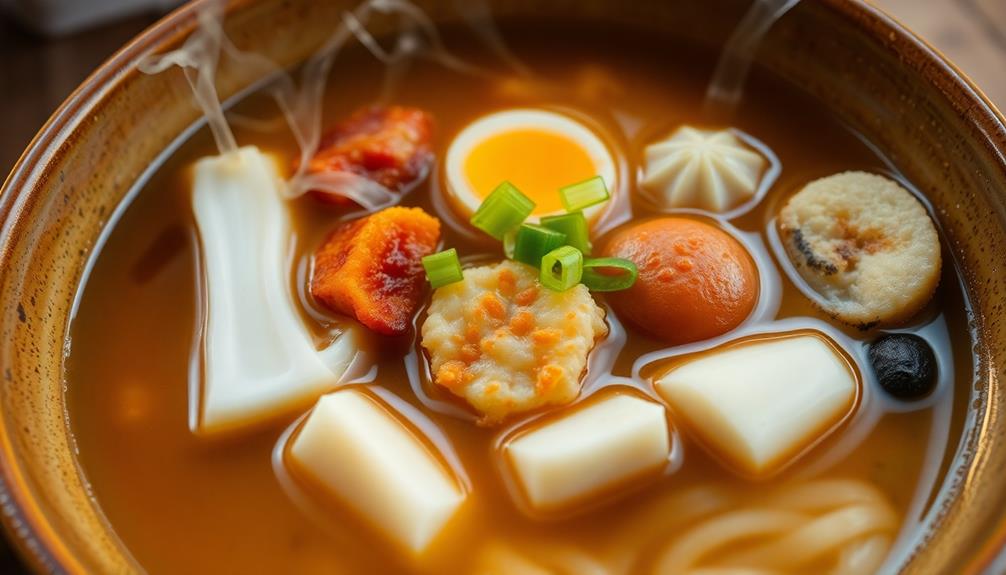
After the 10-minute simmer, it's time to ladle the oden ingredients into individual bowls.
Start by grabbing your serving bowls and placing them on a heat-safe surface. Using a large ladle, begin scooping the simmered ingredients from the pot, distributing them evenly among the bowls.
Make sure to include a variety of items, like the soft-boiled eggs, daikon radish, konnyaku, and any other tasty morsels. As you ladle, try to get a bit of the savory broth in each bowl too. This will help all the flavors mingle together perfectly. For an added pop of flavor, sprinkling some chopped scallions and a few drops of soy sauce on top of each bowl can really take your dish to the next level. And don’t forget to serve the oyakodon recipe with a side of steamed rice for a complete and satisfying meal. The combination of the tender chicken, creamy eggs, and flavorful broth will have everyone coming back for seconds!
Once the bowls are filled, you can garnish the oden with a sprinkle of green onions or a dash of soy sauce, if desired.
Now your guests can dig in and enjoy this comforting, winter dish. The warmth of the broth and the tender ingredients are sure to hit the spot on a chilly day.
Step 5. Garnish With Chopped Green Onions
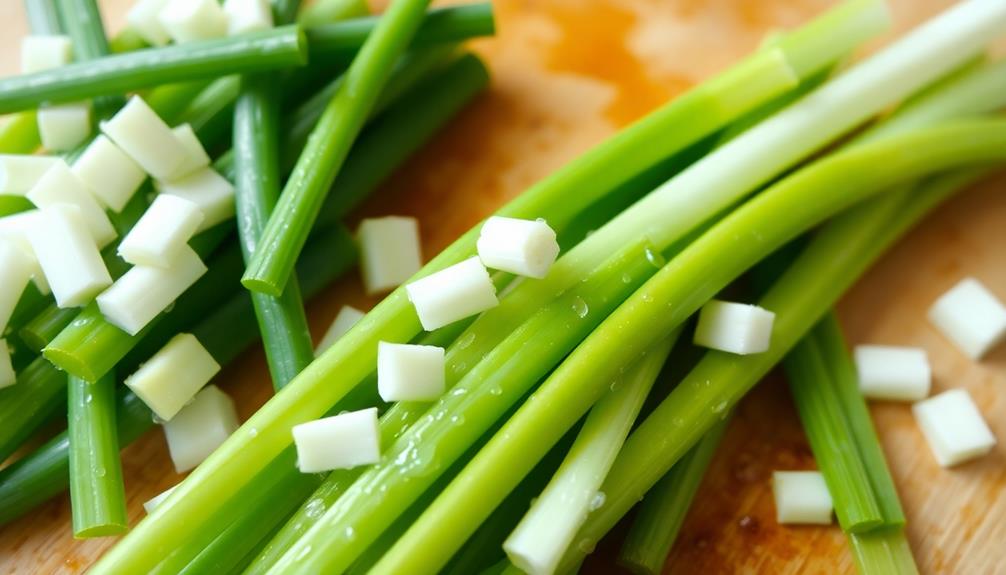
As a final flourish, chop some fresh green onions and sprinkle them over the top of the filled oden bowls. The vibrant green onions add a burst of color and a refreshing, slightly pungent flavor to balance the rich, savory broth.
Using a sharp knife, thinly slice the green onions, making sure to include both the green tops and the white bottoms. Distribute the chopped onions evenly over the oden, ensuring each serving gets a nice garnish.
The contrast of the bright green onions against the steaming, comforting oden creates a visually appealing and appetizing presentation. This simple finishing touch elevates the dish, making it even more inviting and enjoyable.
The fresh, aromatic green onions provide a lovely, crisp texture and a touch of freshness to the hearty, soothing oden, completing the perfect winter meal.
Final Thoughts
Oden, the quintessential winter hotpot, stands as a testament to Japan's culinary prowess. As you sip the savory broth and savor the tender ingredients, you can't help but feel a sense of comfort and nostalgia.
The beauty of oden lies in its simplicity – a harmonious blend of flavors that come together to create a truly satisfying meal.
While the preparation may take some time, the end result is well worth the effort. Don't be afraid to experiment with different ingredients to suit your personal preferences. The joy of oden is in the customization, allowing you to craft a dish that's uniquely your own.
As the temperature drops and the winter chill sets in, gather your loved ones and indulge in the warmth and comforting flavors of oden.
It's a tradition that transcends time and culture, reminding us of the simple pleasures that can be found in the kitchen.
